The vast lava flows of six major and numerous smaller volcanoes have uplifted and joined over a millions of years to form what is now the island of Isabela. By far the largest landmass in the Galapagos, Isabela measures more then 130 km from north to south and 70 km at its widest point. Isabela has several unique animals, including the worlds's only surviving population of mangrove finch, and giant tortoises that have been isolated long enough on their respective volcanoes to evolve into distinct subspecies.
The waters of the Canal Bolivar between Isabela and Fernandina are one of the best stretches in which to see cetaceans (whales and dolphins) in the Galapagos. Be on the lookout during daylight hours wherever you travel between the islands, Bryde's whale is the most common large species encountered, but also reliable area for killer whales and you would be unlucky if you did not see a pod or two of bottlenose dolphins.
 Puerto Villamil is not on the itinerary of most cruise boats, but it is the starting point to ascend Sierra Negra, the only active volcano in the Galapagos that could be climbed by visitors at the time of writing. Quinta Playa, a brackish lagoon west of town, is resident Galapagos pintails, black-necked stilts and moorhens. Puerto Villamil is not on the itinerary of most cruise boats, but it is the starting point to ascend Sierra Negra, the only active volcano in the Galapagos that could be climbed by visitors at the time of writing. Quinta Playa, a brackish lagoon west of town, is resident Galapagos pintails, black-necked stilts and moorhens.
Attractions: white sandy beach, marine iguanas, giant mangroves, small land tortoises, Blue-footed Boobies, iguanas. Activities: HK = Hiking Landing: dry
Humedales (Wetlands) located on the south of Isabela, outside of Port of Villamil, it is a series of lagoons, swamps and mangrooves known for their migrant bird populations. The Wetlands site is made up of a complex of trails that include the following sites: Cerro Orchilla, a lookout which you can access via a staircase; from this site you can see the bay and the town of Puerto Villamil, Sierra Negra Volcano, the Cerro Azul Volcano, islets and rocks. These sites form spectacular scenery.
Attractions: Common Stilts, Flamingos, Whimbrels, White-Cheeked Pintails, and Gallinules (birds)Activities: HK = Hiking Landing: Dry
Breeding Center Arnaldo Tupiza is where giant tortoises are reared on Isabela. It is located 1.5 kilometers from Pto. Villamil, this important center has a captive breeding program for tortoises from the populations of southern Isabela. Here you can learn about the processes of reproduction and breeding. In total there are about 300 tortoises of all size between juveniles and adults. Isabela Island is the only island in the world which has 5 different species of these giant reptiles.
Attractions: giant tortoises Activities: Walking Landing: dry
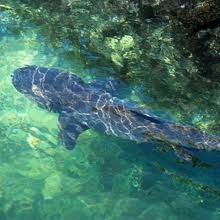
Las Tintoreras is a small bay on an islet, located 5 minutes on a dinghy ride from Port of Villamil, which permits the visitor to observe the White tipped shark. There is a colony of skarks that can often be seen resting in the lava canal. In addition to the sharks there are sea lions, sea turtles, marine iguanas, and rays in the beautiful, calm turquoise waters. Volcano Alcedo is one of the five shield volcanoes that form Albemarle Island the famous "Geyser" or hot steam fumarole will be reached, while all around are Galapagos giant tortoises of the Alcedo race.
Nearby hundreds of marine iguanas can be observed, as 'Las Tintoreras' is one of their main breeding sites. On the nearby sandy beaches, sea lions play and relax in the sun. This is one of Isabela's most beautiful visitor sites.
Attractions: Mangrove forest, flamingos, sea turtles, penguins, rays, herons
Activities: HK = Hiking Landing: dry
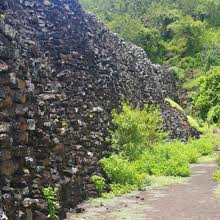 The Wall of Tears also known as Mura de la Lagrimas, the wall was constructed between 1946 and 1959 while Isabela was a penal colony. As punishment the prisoners were forced to build the wall from huge blocks of lava. The wall is named for the many convicts that died while building the wall; Wall of Tears or Muro de las Lagrimas. The Wall of Tears also known as Mura de la Lagrimas, the wall was constructed between 1946 and 1959 while Isabela was a penal colony. As punishment the prisoners were forced to build the wall from huge blocks of lava. The wall is named for the many convicts that died while building the wall; Wall of Tears or Muro de las Lagrimas.
Attractions: Historical location
Activities: hiking Landing: dry
Volcano Sierra Negra, located at the southern end of Isabela Island, is one of the best and most 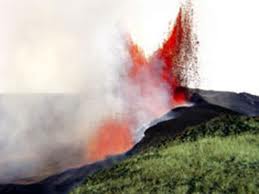 impressive examples of a volcano in the archipelago. Following the edge of the caldera to the north, a place called "Volcan Chico" is reached, comprising a group of small craters, their activity consisting of several different fumaroles. In another area, called the "Sulphur Volcano" the visitor can admire large quantities of sulphur as it has been deposited by the continuous action of fumaroles. Volcano Sierra Negra caldera is the second largest in the world after Ngorongoro in Africa. impressive examples of a volcano in the archipelago. Following the edge of the caldera to the north, a place called "Volcan Chico" is reached, comprising a group of small craters, their activity consisting of several different fumaroles. In another area, called the "Sulphur Volcano" the visitor can admire large quantities of sulphur as it has been deposited by the continuous action of fumaroles. Volcano Sierra Negra caldera is the second largest in the world after Ngorongoro in Africa.
Attractions: Volcano! Basaltic caldera, incredible views
Activities: Hiking, walking, (possible horseback riding) Landing: dry
Breeding Center Arnaldo Tupiz is the Tortoise Breeding Center of Isabela. It is located 1.5 km from Puerto Villamil. In this Breeding Center tortoises from South Isabela (Sierra Negra Volcano, Cerro Azul): Cazuela, Cinco Cerros, Roca Union, San Pedro, Tables and Cerro Paloma have been reproduced in captivity. There has is more than 330 tortoises, between juvenile and adult tortoises at this location.
Arnaldo Tupiz Breeding Center has beautiful gardens consisting of native plants, as manzanillo , mesquite, prickly pear, palo santo, lime prickly-ash, thorn shrub, Galapagos croton, Glorybower, sea island or creole cotton, Radiate-headed, yellow cordia, snowberry or milkberry, myrtle, nickerbean or nickernut, and Darwin's Daisy.
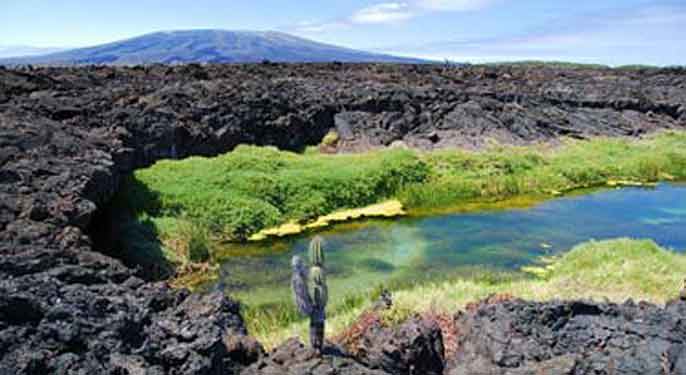 Punta Moreno on the west cost of Isabela is rich in wildlife, particularly where the massifs of Volcan Alecedo and the Sierra Negra join to form a sheltered kink in the coastline. Punta Moreno is reached through mangrove-fringed lagoons with breeding brown pelicans, and flightless cormorant and American Oystercatchers decorating the rocks. Punta Moreno on the west cost of Isabela is rich in wildlife, particularly where the massifs of Volcan Alecedo and the Sierra Negra join to form a sheltered kink in the coastline. Punta Moreno is reached through mangrove-fringed lagoons with breeding brown pelicans, and flightless cormorant and American Oystercatchers decorating the rocks.
Attractions: Flamingos, gallinules, Pintail ducks, turtles, white tip reef sharks and Sea Horses, view of 3 volcanos. Activities: PR = Panga Ride, HK = Hiking, SN = Snorkeling Landing: dry
Elizabeth Bay is an extremely interesting area for 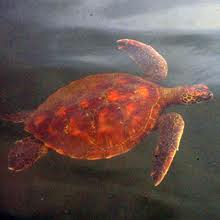 observing marine life of observing marine life of  many different forms. Elizabeth Bay has no landing, boats anchor offshore near the Marielas, two small islets with a scruffy crown of palo santo trees that are good for Galapagos penguins, blue-footed boobies and red-billed tropicbirds. many different forms. Elizabeth Bay has no landing, boats anchor offshore near the Marielas, two small islets with a scruffy crown of palo santo trees that are good for Galapagos penguins, blue-footed boobies and red-billed tropicbirds.
Attractions: Mangrove forest, sea turtles, penguins, rays, herons, sea lions.
Activities: 2 hour panga ride Landing: none
Urbina Bahia, located on the western coast of Albemarle Island at the foot of Alcedo Volcano, 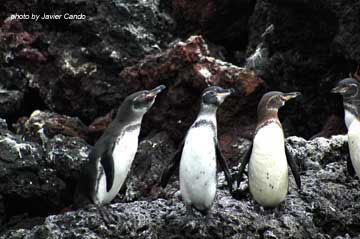 was uplifted from the sea in 1954. The site is relatively flat, distinguished by corals and other marine formations which were lifted out of the sea by the uplift. Flightless cormorants and pelicans nest along the coast during their nesting seasons. a short stretch of black sand flanked by rugged lava outcrops where lava herons hunt for sally lightfoot crabs among some very large marine iguanas and loafing pelicans. Giant tortoises wander down the inland trail from the slopes of Volcan Alcedo to nest and can usaually be seen along the path during the wet season. Some of the largest Galapgos land iguanas in the archipelago are resident here, emerging from their burrows as the day warms up. was uplifted from the sea in 1954. The site is relatively flat, distinguished by corals and other marine formations which were lifted out of the sea by the uplift. Flightless cormorants and pelicans nest along the coast during their nesting seasons. a short stretch of black sand flanked by rugged lava outcrops where lava herons hunt for sally lightfoot crabs among some very large marine iguanas and loafing pelicans. Giant tortoises wander down the inland trail from the slopes of Volcan Alcedo to nest and can usaually be seen along the path during the wet season. Some of the largest Galapgos land iguanas in the archipelago are resident here, emerging from their burrows as the day warms up.
Attractions: The largest Land iguanas, hawks, coral reef, giant tortoises, sea turtles, rays, tropical fish. Activities: PR = Panga Ride, HK = Hiking, SN = Snorkeling Landing: wet
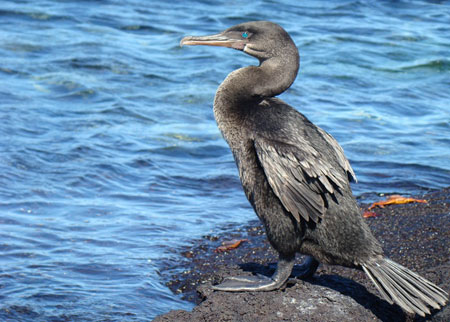 Tagus Cove a tour along the cliffs in a launch will give the visitors a good chance of seeing the exclusive Galapagos penguin, the flightless cormorant, and other sea birds. It is well protected by the slopes of two tuff craters and was used as an anchorage for up to 300 years ago by pirates, whalers and other seafarers. Ship's names dating from 1836 are carved on the rocks. The trail follows the lip of the crater through stands of large, silvery palo santos with scattered Galapagos Cotton and muyuyo, the mixed under story includes a pioneering daisy tree quite unlike the towering scalesias that grow in the highlands. Tagus Cove a tour along the cliffs in a launch will give the visitors a good chance of seeing the exclusive Galapagos penguin, the flightless cormorant, and other sea birds. It is well protected by the slopes of two tuff craters and was used as an anchorage for up to 300 years ago by pirates, whalers and other seafarers. Ship's names dating from 1836 are carved on the rocks. The trail follows the lip of the crater through stands of large, silvery palo santos with scattered Galapagos Cotton and muyuyo, the mixed under story includes a pioneering daisy tree quite unlike the towering scalesias that grow in the highlands.
A panga ride along the base of the cliffs is highly recommended for Galapagos penguin, marine iguanas, sally lightfoots and Galapgos sea lions.
Attractions: Penguins, Flightless Cormorant Activities: PR = Panga Ride, HK = Hiking, SN = Snorkeling Landing: Dry

Vicente Roca Point is made up of two separate coves. Vicente Roca is a large bay with unquie opportunities to view the sea life. This is a cleaning station for Green sea turtles where small fish will feed off of parasites and dead skin on the turtels. Also you should be looking for seahorses and the extremely strange and large Mola-mola (sunfish). Vicente Roca is the nesting area for Flightless Cormorants, there is also Sea Lions, Fur Seals, Galapagos Penguins. There is no landing here, so you take panga ride to the coves and if conditions are good snorkeling is available.
Attractions: Blue-footed Boobies, Penguins, terns, Nazca Boobies, sea lions, sea turtles, rays, puffer fish, sea-horses, Mola-mola fish.
Activities: PR = Panga Ride, HK = Hiking, SN = Snorkeling Landing: none
Flamingo Lagoon which is the largest coastal lagoon found in the Galapagos and is one of the main reproductive sites for the grand majority of flamingos.
Concha de Perla is a kind of a hollow circular enclosure of natural rock, which is fed by the sea with the changing tides. Access to the site is by a wooden walkway, the same that runs through a mangrove forest, up to an intertidal pond. Locals use this site as a place for swimming and snorkeling. If you are fortunate you might be able to swim with sea lions and penguins.
La Calera is located about five minutes by panga from the pier "El Embarcadero". The trail is about 200 meters, crossing for the most part an intertidal zone.
This is land that was used by early settlers of Isabela Island obtaining and preparing materials for building their houses and fixing their boats.
Attractions: Historical site and snorkeling
Activities: PR = Panga Ride, HK = Hiking, SN = Snorkeling Landing: wet
|